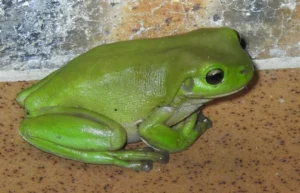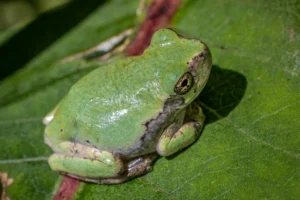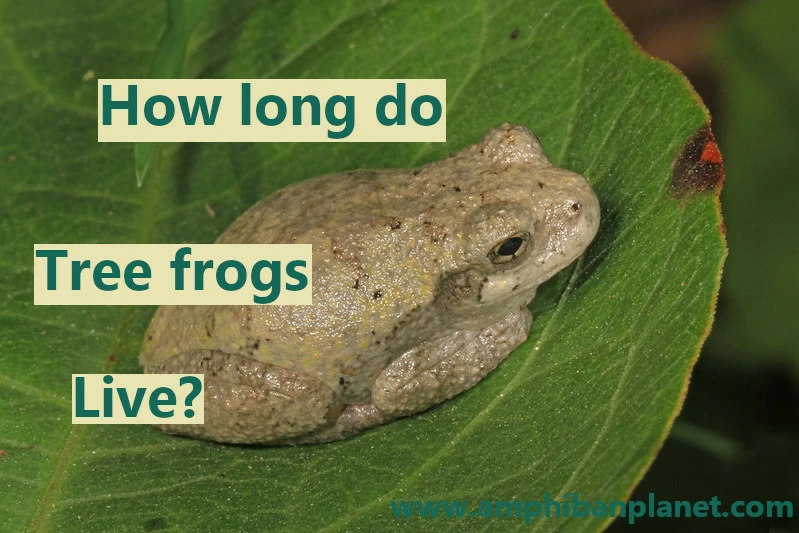How long a tree frog will live depends on many factors. For wild tree frogs, their lifespan will depend on the environment they live in, their diet, and the predators they have to deal with. The lifespan of captive tree frogs is mainly dependent on how well their owners take of them.
Depending on the species, tree frogs can live anywhere from 4 months to as long as 15 years in the wild. However, in captivity, they can live much longer as most of their natural threats are eliminated. Some species have been recorded living up to 21 years in captivity, and some even longer.
There are over 800 tree frog species around the world, so the lifespan varies between different species.
However, captive tree frogs will almost always outlive wild tree frogs provided they are cared for properly.
The Lifespan of 42 Tree Frog Species
As earlier mentioned, how long a tree frog lives is influenced by the species.
For example, Australian green tree frogs commonly live 8 -15 years in the wild and have been known to live up to 21 years in captivity.
Southern cricket frogs on the other hand, usually do not live longer than 1 year in the wild.
Below Is a Table That Shows Approximately How Long 42 Tree Frog Species Live.
Frog Species |
Scientific Name |
Average lifespan in the wild (Years) |
Longest Recorded Lifespan (Years) |
| Gray tree frog | Hyla versicolor | 7 – 9 | 9 |
| Spring peeper | Pseudacris crucifer | 3 – 4 | 6 |
| American green tree frog | Hyla cinerea | 2 – 5 | 6.2 |
| Cuban tree frog | Osteopilus septentrionalis | 5 – 10 | 12.9 |
| Pacific tree frog | Pseudacris regilla | 2 – 3 | 8 |
| Red-eyed tree frog | Agalychnis callidryas | 4 – 5 | 12 |
| Amazon milk frog | Trachycephalus resinifictrix | 8 – 15 | 25 |
| Spotted chorus frog | Pseudacris clarkii | 2 – 3 | N/A |
| Pine woods tree frog | Hyla femoralis | 2 – 3 | 4.4 |
| Barking tree frog | Hyla gratiosa | 5 – 10 | 12.5 |
| Squirrel tree frog | Hyla squirella | 5 – 7 | 8.5 |
| Common Coqui | Eleutherodactylus coqui | 4 – 6 | 6 |
| Australian green tree frog | Litoria caerulea | 8 – 15 | 21 |
| Japanese tree Frog | Hyla japonica | 4 – 6 | 11 |
| European tree frog | Hyla arborea | 8 – 15 | 22 |
| Blanchard’s cricket frog | Acris blanchardi | 1 – 2 | N/A |
| Southern cricket Frog | Acris gryllus | 0.3 – 1 | N/A |
| Northern cricket frog | Acris crepitans | 0.3 – 1 | 4.9 |
| Pine Barrens tree frog | Dryophytes andersonii | 2 – 5 | 7 |
| Boreal chorus frog | Pseudacris maculata | 2 – 3 | 6 |
| Bird-voiced tree frog | Hyla avivoca | 2 – 4 | N/A |
| Waxy Monkey tree frog | Phyllomedusa sauvagii | 7 – 10 | 10.3 |
| Tyrrhenian tree frog | Hyla sarda | 2 – 5 | 5 |
| Coronated tree frog | Anotheca spinosa | 10 – 15 | N/A |
| Western chorus frog | Pseudacris triseriata | 1 – 5 | N/A |
| Hourglass tree frog | Dendropsophus ebraccatus | 4 – 5 | N/A |
| Mediterranean tree frog | Hyla meridionalis | 8 – 12 | N/A |
| Italian tree frog | Hyla intermedia | 8 – 12 | N/A |
| Iberian tree frog | Hyla molleri | 6 – 10 | N/A |
| Lemon-Yellow tree frog | Hyla savignyi | 3 – 6 | N/A |
| Eastern tree frog | Hyla orientalis | 5 – 7 | 8 |
| Indian tree frog | Polypedates maculatus | 4 – 7 | 7 |
| Spencer’s River tree frog | Ranoidea spenceri | 8 -14 | 14 |
| Shovel-headed tree frog | Triprion spatulatus | N/A | 12.8 |
| Common Mexican tree frog | Smilisca baudinii | 4 – 6 | 6.3 |
| Masked tree Frog | Smilisca phaeota | N/A | 4.1 |
| Lowland burrowing tree frog | Smilisca fodiens | N/A | 5.1 |
| Veined tree frog | Trachycephalus typhonius | 8 – 10 | 10.5 |
| Hispaniolan giant tree frog | Osteopilus vastus | N/A | 6.6 |
| Gliding tree Frog | Agalychnis spurrelli | N/A | 5.5 |
| Mexican leaf frog | Agalychnis dacnicolor | N/A | 8.7 |
| Red-spotted Argentina frog | Nyctimantis siemersi | N/A | 5 |
Keep in mind that many of these numbers are not set in stone. Figures recorded in the scientific literature may vary widely.
Also, the maximum longevity recorded for some species may be significantly underestimated.
For example, the maximum age of 6.2 recorded for the American green tree frog (Hyla cinerea) may be underestimated considering the longevity of similar species.
The Longest-Lived Tree Frog?
In 2017, there were several news stories about what could be the oldest tree frog in the world.
His name is Fred, and he is an Australian green tree frog owned by a man called Chris Humfrey.

Chris found the frog climbing the walls in a Coffs Harbour toilet block while on holiday in 1977 and raised him ever since.
Most Australian green tree frogs do not live past the age of 20. So, if Fred really was 40 years old in 2017, he would be exceptional by most standards.
It would make him the oldest tree frog, and one of the oldest frogs in general ever recorded.
Tree Frog Lifespan: Wild vs Captive
In the wild, tree frogs have to deal with many problems that are eliminated when kept in captivity.
For this reason, captive tree frogs will almost always outlive wild tree frogs of the same species, provided they are given proper care.
Factors That Affect a Tree Frog’s Lifespan in the Wild
Several things influence how long a wild tree frog will live.
1. Presence of Predators
In the wild, tree frogs have many predators. Their tadpoles are preyed on by other frogs, newts, fish, snakes many mammals, and even predatory insects such as water boatmen and dragonfly larvae.
Adult tree frogs have to deal with Snakes, birds, skunks, raccoons, and so many other predators.
If a tree frog lives in an area where it is surrounded by predators, it will most likely not live very long.
Although many frogs have several mechanisms to defend themselves from predation, they do not always work.
For this reason, many tree frog species are still vulnerable to many predators – especially when they leave the trees, and descend to the ground.

On the other hand, if a wild tree frog lives in an area with very few predators, it will be able to live longer.
2. Availability of Food
Like us humans, frogs need to eat a balanced diet to remain strong and healthy.
Tree frogs get all the nutrition they need from the wide variety of prey they eat. If there is an abundance of food where a tree frog lives, it can live for a long time.
However, if a tree frog lives in an area where it finds find it hard to find food to eat, the frog is unlikely to live a long life.
3. Disease & Injury
Tree frogs, (and other frogs) can suffer from a variety of illnesses and parasitic infections. They are particularly vulnerable as they age and their immune systems weaken.
A tree frog developing an illness, or getting a parasitic infection can dramatically reduce its life expectancy.
In addition, a wild tree frog getting a simple injury could be fatal. If the injury doesn’t kill it directly, it could reduce its ability to find food, or escape predators.
4. Climate
If a tree frog lives in an environment where the extreme cold in the winter, and extreme heat/dryness in the summer, it could affect its lifespan.
Also, if the weather is ever-changing, or provides unfavorable conditions to frogs (for example, long dry spells), most tree frogs could live shorter lives.
5. Geographic Location
Geographic location and latitude may also affect frog longevity.
One study found that Indian tree frogs (Polypedates maculatus), inhabiting eastern India often live up to 7 years, while those in South India usually do not live longer than 4 years.
It is suggested that this difference may be related to the geographical position of the two regions
In addition, another study found that European common frogs (Rana temporaria) from subarctic regions lived longer than those from other regions.
6. Gender
In many tree frog species, females take longer than males to reach sexual maturity and also live longer.
For example, female Tyrrhenian tree frogs (Hyla sarda) mature 1 year later than males, also typically live 1 year longer.
In Indian tree frogs (Polypedates maculatus), females have been found to live up to 7 years, whereas males only live up to 5 years.
Researchers studying Lemon-Yellow Tree Frogs (Hyla savignyi) found that the mean age of females in their sample was 4.04 years, while it was only 3.63 years for males.
Female Cuban tree frogs (Osteopilus septentrionalis) also usually live longer than the males of their species.
7. Human Activity
Human activity affects a lot of wild animals, frogs included.
Loss of habitat due to clearing of land and development can affect the life expectancy of most tree frog species.
In addition, humans dump waste and toxic liquids in creeks and other water bodies that frogs rely on. Polluted water can genetically modify frogs, stunt their growth, or even kill them.
Factors That Affect a Tree Frogs Lifespan in Captivity
Since some tree frogs have very long lives, it can be difficult for someone to care for a tree frog for several years without a single accident, or even a brief period of neglect.
Something as simple as a tree frog escaping its enclosure could be fatal for the animal.
Due to this, many captive tree frogs do not live to their potential age.
1. Housing & Enclosure
A captive tree frog will need a habitat that very closely replicates its natural environment. Failing to provide this will compromise the welfare of the frog.
In addition, different tree frog species have very specific requirements concerning lighting, temperature, substrate, tank mates, and other things.
Failing to meet the specific housing requirements of a captive tree frog can dramatically affect its life expectancy.
2. Diet
In the wild, tree frogs can get all the nutrients they need from the wide variety of prey they eat. In captivity, their diet is only limited to a few things.
If a captive tree frog is given a low-nutrient diet, it could develop health problems such as metabolic bone disease – and many other conditions that will negatively affect its life expectancy. It could also lead to the tree frog having a weakened immune system.
This weakened immune system would then make it possible for opportunistic infections to cause serious, sometimes and sometimes, fatal illnesses.
3. Handling & General Care
Frogs have highly permeable skin that they use to breathe and regulate the concentration of water and ions in their bodies.
Since their skin is so absorbent, frogs can easily be harmed by oils and salts from human hands.
In addition, lotions, perfumes, soap, insect repellents, sunblock, and other substances can pass right through their skin and end up inside their body.

Frequently handling a captive tree frog, especially with harmful substances on the hands, can irritate its skin, and in some cases, it can even be fatal for the frog.
Also, handling a frog with dry hands can dry out its skin, and cause severe problems for the animal.
All this can dramatically shorten the life of a captive tree frog.
4. Accidents
Sometimes, things go wrong. For beginners, this is usually due to poor knowledge. But even for the experienced, accidents still happen.
One of the most common accidents is a frog escaping from its enclosure. Since frogs need to keep their skin moist, an escaped tree frog may dry out and die if is not found quickly enough.
Another accident could be a power outage or malfunctioning equipment. Since frogs need to be kept in a controlled environment, a simple temperature drop/rise could stress or kill the animals.
The prevalence of accidents means many captive tree frogs die before they can live to their maximum age.
5. Neglect
Captive frogs need ongoing care. If tree frog is neglected for long periods, it could be harmful, or even fatal to the frog.
Also, neglect often leads to dirt and debris building up in the frog’s enclosure. A dirty environment is a perfect place for bacteria and fungi to build up.
This can lead to a frog developing skin lesions and other infections, negatively affecting its life expectancy.
More About Tree Frogs
Learn more about tree frogs in these interesting guides on our site:
Common Tree Frog Longevity Questions
What Is The Maximum Age of a Tree Frog? Generally, Australian green tree frogs are one of the longest-lived tree frogs with a lifespan of about 8 -15 years in the wild. However, one Australian green tree frog was claimed to have lived to the age of 40 in captivity, but this was verified by scientists.
How Long Do Big Tree Frogs Live? Big tree frogs usually (not always) live longer than smaller tree frogs. For example, the Australian green tree frog, and the Amazon milk frog can live up to 15 years in the wild – compared to Southern, and Northern cricket frogs which usually don’t live longer than a year in the wild.
How Long Do Small Tree Frogs Live? Little tree frogs usually (not always) live shorter lives than larger tree frogs. Big tree frogs like the Australian green tree frog are known to live 8 – 15 years in the wild, whereas Southern cricket frogs usually only live about 4 months, and rarely live longer than a year,
Photo credit: Judy Gallagher (CC BY 2.0)
Sources:
Altunışık, Abdullah & Özdemir, Nurhayat. (2013). Body size and age structure of a highland population of Hyla orientalis BEDRIAGA, 1890, in northern Turkey. Herpetozoa. 26. 49-55.
Dufresnes, C., Berroneau, M., Dubey, S. et al. The effect of phylogeographic history on species boundaries: a comparative framework in Hyla tree frogs. Sci Rep 10, 5502 (2020). https://doi.org/10.1038/s41598-020-62382-4
Graeme R Gillespie “Life History Variation in the Spotted Tree Frog, Litoria spenceri (Anura: Hylidae), from Southeastern Australia,” Herpetologica 67(1), 10-22, (1 March 2011). https://doi.org/10.1655/HERPETOLOGICA-D-10-0011.1
PRAVATI K. MAHAPATRA & SUSAMA NAYAK & SUSHIL K. DUTTA.( 2008). Age estimates for a population of the Indian Tree Frog Polypedates maculatus (GRAY, 1833) (Anura: Rhacophoridae). HERPETOZOA (PDF). https://www.zobodat.at/pdf/HER_21_1_2_0031-0040.pdf
G. Cadeddu, C. Giacoma, S. Castellano. “Sexual size dimorphism in the Tyrrhenian tree frog: a life-history perspective” Journal of Zoology (22nd November 2011). https://doi.org/10.1111/j.1469-7998.2011.00878.x
Patrelle, Cecile & Hjernquist, Mårten & Laurila, Anssi & Soderman, F. & Merila, J.. (2012). Sex differences in age structure, growth rate and body size of common frogs Rana temporaria in the subarctic. Polar Biology. 35. 1505-1513. 10.1007/s00300-012-1190-7.
Alaeir, Pesaraklooa. Najibzadehm.,& Mirkamalis. J. (2021). Life-history traits and the first demographic data of Iranian population of the West Asian Lemon-Yellow Tree Frog, Hyla savignyi (Audouin, 1827). Acta Zoologica Academiae Scientiarum Hungaricae, 67(3), 247–261. https://doi.org/10.17109/AZH.67.3.247.202


